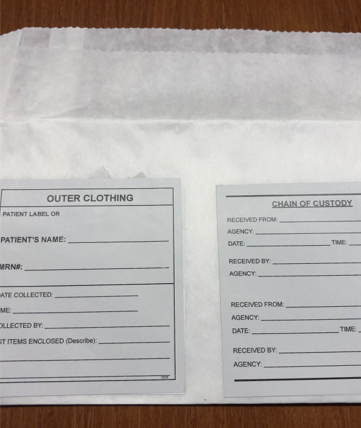
Step 5: Clothing Collection
Recover possible foreign matter or DNA, note any damage to clothing. Regardless if the patient changed clothes after the sexual assault, the examiner should always collect underwear if the patient consents.
- Put on new gloves
- Place a clean sheet on the floor
- Take the large changing paper out of the SAEK and spread it out on top of the clean sheet
- Have the patient stand in the middle of the changing paper
- Provide the patient some privacy when removing clothing (i.e., hold up a gown)
- Have the patient place individual items in separate areas on the changing paper
- Label the changing paper
- Inspect each piece of clothing. Document item, color, and any damage on the forensic record
- Label each item of clothing with patient’s name, date seen and examiner’s initials. Consider photographing damaged or stained clothing
- Place each item of clothing in a separate paper bag. Clothing does not go in the SAEK
- Dry wet clothing, if unable to dry wet clothing…
- Arrange for release to law enforcement with chain of custody
- Notify law enforcement that the clothing is wet, so drying arrangements can be made
- Bag each item individually to prevent cross-contamination
- Seal and label each bag with date, time and examiner’s initials
- Seal all clothing bags inside a large bag
- Seal and label large bag with date, time and examiner’s initials
- Label each large bag with a number
- For example, if there is a SAEK plus one bag of clothing, label SAEK “1 of 2” and bag “2 of 2”
For more information on collecting clothing see the Protocol.
X
Instagram
Linked in
RSSYouTube